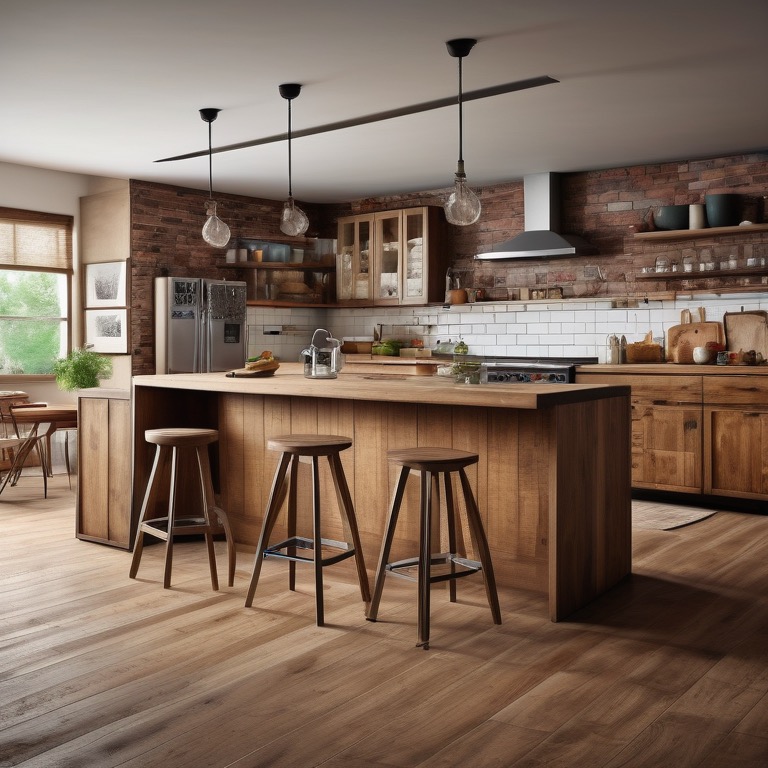How Kitchen Furniture Has Changed Over Time

How Kitchen Furniture Has Changed Over Time
The heart of every home is undoubtedly the kitchen. From humble beginnings as functional spaces tucked out of sight, kitchens have evolved into aesthetically appealing, multifunctional rooms fitted with modern technologies. In this blog, we delve into the evolution of kitchen furniture, mapping out its tremendous transformation over time. From charming timber doors made in West Yorkshire to sparkling modern granite countertops, be ready for an exciting chronological journey. Along the way, we highlight significant turn points, emphasising innovations that added the 'wow factor' to the once merely practical room. We also delve into the future of kitchen furniture, offering insights into what to anticipate in coming years. With the introduction of elegant kitchen and dining furniture sets, the kitchen has become not only a functional space but also a stylish and inviting room for family and friends to gather. And with the flexibility and variety offered in our designs, choosing a new kitchen has never been easier.
The Evolution of Kitchens
Looking back at history, the kitchen's role has developed remarkably. Traditionally, kitchens were hidden from guests' view, serving as cooking areas and nothing more. As time passed, they morphed into social hubs, places where family and friends could congregate for meals, chats, and bonding moments. Accompanying this social evolution was a change in kitchen furniture and layout. Over the years, design trends have offered various styles, reflecting social changes, technological advancements, and economic conditions. From the utilitarian Georgian kitchen to the futuristic 'smart' kitchen, the changes have been nothing short of remarkable.
Historical Development of Kitchen Furniture
The development of kitchen furniture adds an interesting twist to the tale of kitchen evolution. What started as basic cabinets and shelves used for storage has now morphed into sleek, multi-functional designs that have stood the test of time. These changes were influenced by factors like the need for improved functionality, advancement in technology, and shifting homeowner preferences. The journey of stylish kitchen furniture's evolution provides fascinating insights into how the most loved room in our homes has changed over time.
Pre-19th Century Kitchens
The Georgian kitchen, characterised by painted woodwork, was set in basement rooms, often used by servants. Back then, aesthetics took a backseat to functionality. Kitchen walls and cabinets were decorated in single colours, mostly matt finish shades of grey or blue. Some of these kitchens had designated rooms for different tasks; a kitchen for cooking, a scullery for washing, and pantries and larders for storage. Marble, favoured by the Georgians, was a common feature in worktops and sinks, including the popular butler or Belfast sink. Design features such as butt hinges and dovetail drawers were quintessential components of this period, reflecting the devotion for quality craftsmanship. The Georgian era laid the groundwork for the modern kitchen, emphasising practicality and straightforward design elements.
19th Century Advancements
The Victorian kitchen brought about a significant shift from the Georgian era. Unlike earlier, these kitchens were designed with style and a sense of welcoming warmth. Different colour palettes were adopted, leaning more toward soft greys, creams, and lime. Particular attention was on combining solid wood with bright, clean worktops – a Victorian era signature style. Copper started making an appearance in kitchens, fitting in as pots, pans, and taps, adding an earthy glow to the surroundings. This era was all about balance; combining robust utility with a tasteful blend of colour and materials - a phenomenon that set the stage for more innovative designs to come in the following century.
Early 20th Century Trends
With the advent of the 20th century came several groundbreaking developments. The discovery of electricity and gas cooking methodologies redefined kitchen functions and aesthetics. Edwardian kitchens boasted larger sinks, ushering in the significance of sinks as kitchen focal points. Cabinets became an essential inclusion to store the rising number of pre-packaged foods. White became the top choice for kitchen colours; it was easy to clean and created an impression of sterile, hygienic spaces. Copper made an exit, being replaced by enamelled iron, while glass-fronted cupboards took over open shelving. The explosion of colours in kitchen furniture became an expression of individuality and a sense of personal style.
Mid-20th Century Transformations
The mid-20th century brought with it many game-changing kitchen trends. Open-plan kitchens began to gain popularity, addressing the needs for multifunctionality and social engagement. Functional spaces such as dining areas were merged with the kitchen, and areas were repurposed to create a unified, cohesive layout. Cabinets featuring wood veneers and laminate countertops designed with bold colours and patterns were all the rage. With the boom of colourful appliances, kitchens started to embrace stronger colours, breaking away from the previously favoured all-white kitchens. From canary yellow to seafoam green, these hues made their way to cabinet doors, creating vibrant and lively spaces.
Late 20th Century Modernisation
In the late 20th century, kitchens witnessed a blend of tradition and modernisation. Sleek, flat-door cabinets replaced elaborate, wood-carved models, signalling the emergence of a minimalist trend. Stainless steel appliances became a 'must-have', giving kitchens a futuristic edge. The cabinet door designs saw a revamp, with glass inserts becoming popular, adding an element of transparency to the kitchen layout. The feature-packed 'island' became a new norm, serving multiple purposes from food prep area to entertaining guests. With the rise of modernisation, cabinetry options expanded to include sleek and functional designs, such as base cabinets, making them an essential part of any contemporary kitchen.
Painted Kitchen Furniture and Color Trends
From monochromatic eras to periods of vibrant tones, colour has played a significant role in the evolution of kitchen furniture. It not only impacts the aesthetics of a space but can also significantly affect one's mood and perception of the room's size and illumination. Moving beyond the limitations of natural wood, painted kitchen furniture provided an opportunity for creativity, allowing homeowners to truly personalise their spaces within commercial constraints. With the ability to change the colour of wood through painting, homeowners could easily keep up with colour trends and adapt their kitchen furniture to their personal style.
Painted furniture in historical context
Starting from the Georgian era, painted kitchen furniture has been a consistent trend through the ages. In the early days, the simplicity of single-tone painted kitchens created a calm and orderly atmosphere. The Victorians adopted a more intricate approach, introducing cream cabinets and contrasting wooden work surfaces. These painted kitchens added visual interest and allowed individual personality to shine. Not only were these colour variations aesthetically pleasing, they also had a significant impact on the perceived space and light within the kitchen. The use of wood cabinets in combination with painted cabinets was a hallmark of Victorian kitchen design, creating a beautiful contrast and adding to the overall aesthetic.
Modern paint techniques for kitchen furniture
Modern painting techniques have revolutionised kitchen design. These techniques offer an array of options like distressing, stencilling, sponging, and glazing. Consequently, homeowners can now give their kitchen furniture a touch of personal style. The high-tech, glossy finish of fitted kitchens contrast well with a vintage style created by distressing techniques or cream kitchen furniture. On the other hand, patterns produced by sponging provide a subtle elegance. Glazes are used to achieve an aesthetically pleasing antique look, adding depth to the kitchen decor. The possibilities are endless, giving every homeowner the freedom to define their dream kitchen.
Popular colour trends in painted kitchens
Grey and white lead the list of popular colours for modern-day kitchens. They offer an excellent backdrop for accent colours and can easily adapt to different styles, from a sleek, modern design to a traditional country kitchen. Black kitchens are also gaining popularity due to their dramatic, glamorous look, while pops of colour like navy blue or rich, emerald green are being increasingly used on cabinets, walls, and even appliances.
From the soft pastels of the mid-20th century to the bold colours of today, colour trends have drastically evolved. But one thing remains consistent – painted kitchen furniture continues to be an essential part of a stylish and comfortable kitchen.
The Future of Kitchen Furniture
As we leap into the future, kitchen furniture continues its evolutionary journey. Emerging themes showcase an exciting blend of technological advancements and a strong commitment towards sustainability. Embracing 'smart' features and eco-friendly materials holds the promise of reshaping future kitchens into energy-efficient spaces offering unparalleled comfort and convenience. Let's explore what the future has in store for kitchen design with the release of a new edition. In the interest of continuous product improvement, we reserve the right to alter specifications as necessary.
Smart Kitchens and Connectivity
Technology is augmenting our lifestyles, and kitchens are no exception. The concept of smart kitchens is revolutionising kitchen functions, creating a seamless cooking experience. Digital voice assistants, smart refrigerators, and even smart faucets are rapidly becoming mainstream. Appliances equipped with artificial intelligence can suggest recipes, order groceries, and even help with cleaning up.
Digital connectivity is transforming the dream kitchen into a highly organised, efficient, and personalised space, creating an environment where cooking becomes a delightful experience rather than a chore.
Sustainable and Eco-friendly Materials
Sustainability is a rising trend in kitchen designs. There is an increasing demand for kitchen furniture made from eco-friendly materials. Recycled metals, bamboo, and reclaimed wood are gaining popularity as alternatives to traditional materials. The move towards energy-efficient appliances, waste reduction, and sustainable sourcing reflects a growing concern for the environment.
These trends not only minimise environmental impact but also enhance the kitchen's aesthetic value. By adopting greener practices in our kitchens, we not only create a healthier home but also contribute to a more sustainable and environmentally-friendly future.
Kitchens have come a long way from being just a functional place for meal prep to becoming a space that showcases one's personal style, functionality, and sustainability. The journey of kitchen furniture's evolution offers a fascinating reflection of mankind's innovative spirit. The future looks promising, with more emphasis on smart features and sustainable materials. And so, it seems that the heart of every home - the kitchen, will continue to evolve and echo the changes in technology, societal norms, housing trends, and human needs, all while retaining its warmth and character.
